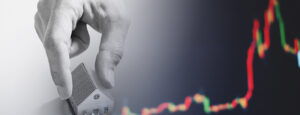Patrick Iturra Report Estate Investments Group
INTRODUCTION: WHAT IS A HOUSING BUBBLE?
A real estate bubble, commonly known as a housing bubble, is caused by an economic phenomenon called speculation, wherein investors buy property in [the hopes of making more money] off it in the future since its price will rise. It is a sudden jump in demand for housing property despite limited inventory at the time. Due to factors like demand, speculation, and massive spending capacities, real estate prices increase rapidly. While the increasing costs of real estate incentives more investors to put their money in real estate, these prices are incredibly high, so they cannot be sustained for a more extended period. The real estate market is bound to collapse when such a local or global housing bubble pops and has significant repercussions for all stakeholders involved. One important character trait of a real estate bubble is that it is temporary yet very impactful. This article details at length the precarious situation looming over the United States market. It identified a housing bubble’s general causes, consequences, and characteristics before specifically analyzing the U.S. market.
- What Causes a Housing Bubble?
The ability to identify and prevent a housing bubble has been a hotly debated topic between different economic schools for a long time now. Intricately woven together with speculation, the nature of supply and demand plays an essential role in causing a housing bubble. The impact of speculators creates an imbalance between the number of buyers and the number of commodities available to buy. Additionally, a general increment in an average person’s life, new inflow of a lot of buyers of real estate in the market, low-interest rates, the introduction of unique and innovative properties, higher tendency of taking risks by a buyer due to financial illiteracy, and easy access to credit may also directly cause a housing bubble.
- What Makes a Housing Bubble Pop?
A housing bubble is a temporary occurrence and is bound to collapse as suddenly as it emerges. However, organizations like the International Monetary Fund (IMF) say that a bubble may persist for several years. A housing bubble pops when the prices of housing properties drastically decrease and come back to what is regarded as fundamental and sustainable. This happens when:
- Demand decreases while production is still on the rise;
- Interest rates are increasing, making it extremely difficult for people to afford homes, let alone buying higher-end property;
- The economy takes a hit in terms of unemployment, lesser per capita income, etc.
- The realization of risk discourages individuals from buying property;
- Moneylenders recognize only those people who can repay the money;
- Speculators leave the market.

- Problems Caused by a Housing Bubble
Housing bubbles can not only determine the state of a real estate industry but other key players in the market such as homeowners (and their finances), investors, and commercial properties as well. Elements of the loaning system like interest rates, lending standards, and securitization get affected. There have been multiple shreds of evidence suggesting how people used up their savings and even went bankrupt to keep up with the sky-scraping prices prevailing in the real estate industry during a housing bubble.
BRIEF HISTORY OF THE 2007-08 U.S. HOUSING BUBBLE
The mid-2000s witnessed a massive housing bubble in the United States of America, to the extent that it became a significant factor that caused the Great Recession. In the wake of this housing bubble, real estate industries worldwide conceded an extensive and disastrous outcome. The mortgage and credit crisis arose out of poor lending standards, nominal interest rates, and low down payments, enabling individuals who earlier could never afford houses to become house owners of wealthy properties, no less. The roots of this bubble are in the actions of the U.S. government in 1999. It sponsored lenders Fannie Mae and Freddie Mac to make home loans available even to those who did not fall under the eligibility ambit, such as people with low credit scores and negligible capability to repay. Such borrowers came to be known as subprime borrowers.
Many reports claim that on September 06, 2008, the financial markets in the U.S. were down almost 20% than just a month before. A series of government bailouts, credit down gradation, and redemption requests dominated the market. What followed was the large-scale loss of revenue by behemoth lenders and housing firms since subprime borrowers were faulted and went bankrupt. What followed was the large-scale loss of income by behemoth lenders and housing firms since subprime borrowers were criticized and went bankrupt. What followed was the large-scale loss of revenue by behemoth lenders and housing firms since subprime borrowers were faulted and went bankrupt.
SIGNS THAT THE U.S. HAS AN IMPENDING HOUSING BUBBLE
The pandemic has been the most important lesson to teach humanity the importance of a roof on top of our heads. The future of the real estate industry in the U.S. must be shaped through thoughtful decisions not to repeat the 2007 mishap. Though the U.S. real estate industry is currently not shouldering the brunt of another devastating housing bubble, economists warn the government, the citizens as well as all international stakeholders to be wary of the following three note-worthy signs that indicate it:
Housing Prices are Above Bubble Levels
The Case-Shiller National Home Price Index has traditionally been the most trusted metric for judging nationwide price growth. Today, it indicates a boom higher than what was seen in the 2000s. There is a lot of demand for a minimal supply of housing properties for various reasons. The consequence of this is the prices spiking up way past what is regarded as housing bubble highs from the previous decade.
Rents are Ever-Increasing
As per reports from the 2007 housing bubble, the nationwide price-to-rent ratio rose above 1.5 just before the housing market suddenly saw many investors. Cut to Mat 2020; the national percentage is again at a staggering 1.45, which may cause worry. Though some experts have suggested that COVID-19 has been the primary reason behind the hike, others believe that the ratio is not as concerning as in 2006.
Housing Properties are Rapidly Being Sold
The U.S. is currently experiencing a record high number of homes being sold since 2008. Consequently, the meantime a property spends on the market has also drastically reduced- from mere days instead of months- meaning that the rate of properties being bought in 2020 has also picked up the pace. Frenzied bidding wars have constantly been the reason behind houses being sold at much higher prices. The relatively wealthier market section has the upper hand in winning such raging bidding wars, hinting towards speculation.
Patrick Iturra Report Estate Investments Group





